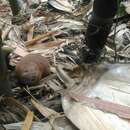en
names in breadcrumbs


Perception Channels: tactile ; chemical
US Federal List: no special status
CITES: no special status
IUCN Red List of Threatened Species: least concern
C. badius will inhabit tea gardens and construct burrows and tunnel systems in them, damaging these crops (Nowak, 1999).
Cannomys badius is important to many tribes in the Burmese hills. These tribes hunt the lesser bamboo rat for food (Nowak, 1999).
C. badius eats mostly bamboo roots and shoots but also consume shrubs, young shoots of grasses and other roots, and will eat seeds and fruits (Anderson, 1984, Grzimek,1990).
Cannomys badius is found in Nepal, northern and eastern Bangladesh, northern Cambodia, northern Vietnam, Bhutan, Assam, southwestern Yunnan, Burma, Thailand, and Laos (Nowak, 1999).
Biogeographic Regions: oriental (Native )
Cannomys badius inhabit thicket and bamboo forests and hilly mountainous regions (Anderson, 1984) and are sometimes found at high elevations (Grzimek, 1975).
Terrestrial Biomes: forest ; mountains
Average lifespan
Status: captivity: 3.3 years.
Body length of Cannomys badius is 6.4 to 18 inches (Grzimek, 1990). Commonly called the lesser bamboo rat, it has small ears and eyes and greatly resembles the American poket gopher, except in its lack of cheek pouches. C. badius has thick fur on its head and body with less fur on its tail. This mammal ranges in color from reddish cinnamon and chesnut brown to ashy gray and plumbeous. Some individuals possess a white band on the top of the head and a narrower band from the chin to throat (Nowak, 1999).
Cannomys badius is a medium sized mammal with short, powerful legs (Anderson, 1984). They posses long, powerful digging claws and smooth pads on the soles of the feet (Nowak, 1999). C. badius have large incisors and molars that have flat crowns and roots (Grzimek, 1975). The zygomatic arch is very wide and the body is thick and heavy. Female lesser bamboo rats have two pectoral and two abdominal pairs of mammae (Nowak, 1999).
Range mass: 500 to 4000 g.
Other Physical Features: endothermic ; bilateral symmetry
Average basal metabolic rate: 0.96 W.
Female Cannomys badius can bear one to five young per birth (Grzimek, 1990). Breeding usually occurs during the wet seasons and gestation lasts about six or seven weeks (Anderson, 1984). The young develop relatively slowly, weaning periods are unknown (Nowak, 1999).
Key Reproductive Features: gonochoric/gonochoristic/dioecious (sexes separate); sexual
Average birth mass: 7 g.
Average gestation period: 42 days.
Average number of offspring: 1.8.
The lesser bamboo rat (Cannomys badius) is a species of rodent in the family Spalacidae. It is monotypic within the genus Cannomys.[2] It is found in Bangladesh, Bhutan, Cambodia, China, India, Myanmar, Nepal, and Thailand.
The lesser bamboo rat is a small, stocky mole-like rat. It reaches a length of about 200 mm (8 in) with a tail of around 60 mm (2 in), weighing between 210 and 340 grams (7.4 and 12.0 oz). The ears are small and completely hidden in the coat. The fur is soft and dense, reddish-brown to greyish-brown on the upper parts and rather paler and thinner on the underparts. Sometimes, white stripes are on the crown of the head or some white on the throat. The tail has a few hairs.[2] Lesser bamboo rats have a robust, cylindrical body, small ears and eyes, and short, stout legs.[3]
The lesser bamboo rat is a burrowing animal usually found in bamboo groves in mountainous areas, but also occurring in woodland, plantations, and disturbed ground. The burrow entrance may be at the foot of a tree, under a clump of bamboo, in a bank, or in the open. Excavated earth is flung up in a mound at the entrance of the tunnel and further mounds occur at intervals along the course of the burrow. The main tunnel runs horizontally beneath the surface and may reach a depth of 60 cm (24 in) and total length as long as 58 m (190 ft). It ends in a roomy nesting chamber. When the animal is underground, the entrance of the burrow is plugged with earth.[2]
The lesser bamboo rat emerges above ground at dusk to forage for plant material such as shoots, especially of bamboo, and roots. These rats become sexually mature at the age of one year and females produce litters of two to five offspring after a gestation period of about six weeks. Weaning takes place some eight weeks later.[2]
The lesser bamboo rat has a wide range and is abundant in places. The threats it faces include being hunted for food and killed as a pest in rubber plantations. The International Union for Conservation of Nature has listed its conservation status as being of "least concern".[1]
The lesser bamboo rat (Cannomys badius) is a species of rodent in the family Spalacidae. It is monotypic within the genus Cannomys. It is found in Bangladesh, Bhutan, Cambodia, China, India, Myanmar, Nepal, and Thailand.